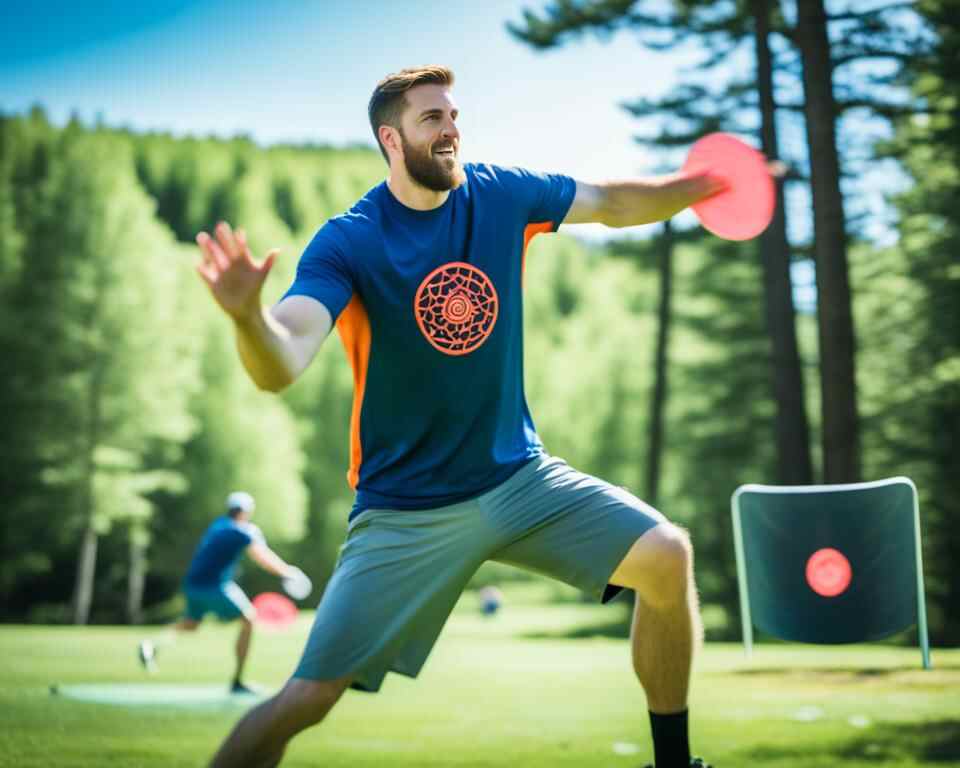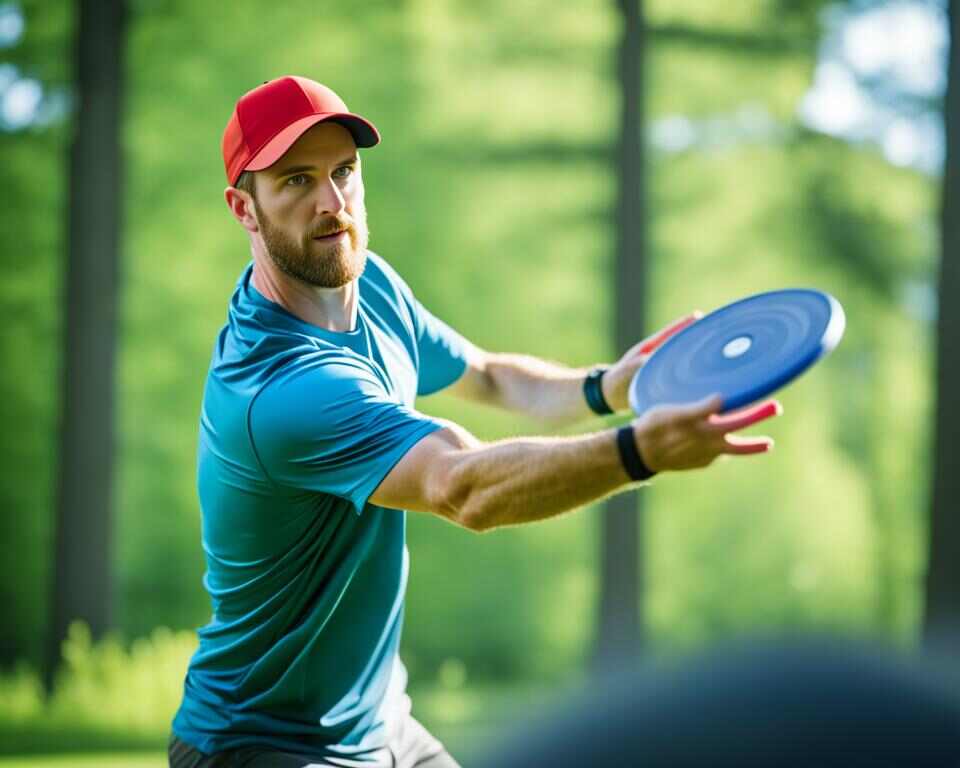When it comes to disc golf, there’s more to it than just throwing a frisbee into a basket. Have you ever wondered about the significance of the circle in disc golf? Why is it so important and how does it impact the game? Well, get ready to dive into the world of disc golf and uncover the secrets of the circle.
Disc golf can be a challenging and strategic sport, and the circle plays a crucial role in determining the putting zone for each hole. But what exactly is the circle? And what are the rules and strategies associated with it? In this article, we’ll break it down and explore the measurements, rules, and significance of the circle in disc golf.
So, if you’re ready to take your disc golf knowledge to the next level and gain a competitive edge on the course, read on. You’ll soon discover how understanding the circle can lead to improved putting skills and a better overall game.
Key Takeaways:
- The circle in disc golf defines the putting zone for each hole.
- It is divided into Circle 1 and Circle 2, with Circle 1 being within 10 meters of the basket.
- Circle 2 is an unofficial marker used for analysis purposes.
- Understanding the circle measurements is crucial for accurate shot calculations and strategic gameplay.
- Mastery of the circle and its rules can lead to improved putting skills and overall performance in disc golf.
What is the Circle in Disc Golf?
The circle in disc golf is a designated area around the basket that determines the putting zone for each hole. It plays a crucial role in the scoring and strategy of the game, and understanding its measurements and rules is essential for players to improve their putting skills and overall performance.

Importance of Circle Measurements in Disc Golf
Circle measurements are essential for defining the boundaries of the putting area and differentiating between Circle 1 and Circle 2. Circle 1 is within 10 meters (32.8 ft) of the basket and any throw from this area is considered a putt. Circle 2, on the other hand, is between 10 meters and 20 meters (32.8 ft to 65.6 ft) from the basket and is an unofficial marker used for analysis purposes.
By understanding the circle measurements, players can strategize their shots, calculate distances accurately, and improve their putting skills. It provides a clear guideline for players to determine their throwing techniques and angles within the designated putting zone.
Circle 2: The Unofficial Yet Significant Marker
Although Circle 2 is not officially marked on the course, it serves as a critical marker for analysis and evaluation. Players often use Circle 2 as a reference point to assess their performance and identify areas of improvement. Analyzing the success rate of putts from Circle 2 provides valuable insights into a player’s long-range putting capabilities and helps in making strategic decisions during gameplay.
While not directly impacting the score, Circle 2 plays a significant role in fine-tuning player skills and enhancing performance. Understanding the correlation between Circle 2 success and overall scores allows players to prioritize their practice and focus on specific areas to improve their overall disc golf abilities.
The Role and Rules of Circle 1 in Disc Golf
Within the sport of disc golf, Circle 1 plays a vital role in defining the official putting zone. It refers to the area that extends 10 meters (32.8 ft) from the basket. Any throw made from within this circle is considered a putt. Understanding the rules and strategies associated with Circle 1 is essential for players to navigate the game successfully and improve their overall performance.
Defining Circle 1 in Disc Golf
Circle 1 serves as the official putting zone in disc golf. It encompasses the area that is within 10 meters (32.8 ft) of the basket. Once a player’s disc lands within this circle, they are required to attempt a putt to complete the hole. This area is crucial for scoring, as successful putts from within Circle 1 result in lower scores and contribute to overall success in the game.
Understanding the Putting Rules Inside Circle 1
When it comes to putting inside Circle 1, specific rules dictate player behavior. Balance control is one such rule. After releasing the disc during a putt, players must maintain balance before advancing towards the target. This ensures fair play and prevents players from gaining an unfair advantage by moving closer to the basket.
Proper putting techniques are also crucial inside Circle 1. Players must use a controlled throwing motion to achieve accuracy and avoid violating the rules. Violations can result in penalties, affecting the player’s score and overall standing in the game.
Handling Complex Situations and Penalties
Disc golf can present players with complex situations within Circle 1. For instance, if a player’s disc touches the basket or any other obstacle while attempting a putt, specific rules and penalties come into play. These rules vary based on the particular disc golf organization or tournament regulations in effect.
Understanding how to navigate these complex situations is essential for players to avoid penalties and maintain fair play. Familiarity with the specific rules and penalties associated with Circle 1 helps players make informed decisions and handle challenging scenarios successfully.
Intermediate Disc Golf Areas: Beyond Circle 1
As disc golfers progress in their skills and knowledge of the game, they will encounter various intermediate areas that go beyond the boundaries of Circle 1. These areas present new challenges and require different throwing techniques and strategies to navigate successfully. Let’s explore some of these disc golf areas and their significance in the game.
One of the intermediate areas that players may encounter is the fairway. Fairways are the designated paths leading to the basket, and they often feature a mix of open space and obstacles such as trees, bushes, or water hazards. To navigate through the fairway, players must carefully select their throwing technique and consider the obstacles that lie ahead. Understanding the fairway’s layout and strategically planning each throw can greatly impact a player’s performance and scoring.
Another intermediate area in disc golf is the presence of obstacles. These obstacles can come in various forms, including trees, rocks, or out-of-bounds areas. Negotiating around obstacles requires players to adapt their throwing strategies and choose the right disc for the situation. Skillful shot placement and the ability to maneuver around obstacles effectively can give players a competitive advantage.
Teeing areas also fall within the realm of intermediate disc golf areas. These are the designated starting points for each hole and often have specific rules regarding the throw. Proper foot positioning and understanding the layout of the hole are crucial in achieving an optimal drive from the teeing area. Players must assess each teeing area’s unique characteristics and plan their throws accordingly.

To improve their performance in these intermediate disc golf areas, players must practice and refine their throwing techniques. By mastering shots in fairways, navigating obstacles, and skillfully executing throws from teeing areas, players can optimize their performance, adapt to different course layouts, and ultimately improve their overall scoring. Embracing the challenges presented by these intermediate areas is a crucial step in the development of a well-rounded disc golfer.
| Intermediate Disc Golf Areas | Description |
|---|---|
| Fairways | Designated paths leading to the basket, requiring strategic shot selection and consideration of obstacles. |
| Obstacles | Trees, rocks, or out-of-bounds areas that require players to adapt their throwing strategies. |
| Teeing Areas | Designated starting points for each hole, requiring proper foot positioning and strategic planning. |
Strategies for Mastering Disc Golf Putts
To become a skilled disc golfer, mastering your putts is essential. It requires a combination of proper techniques, strategic decision-making, and a deep understanding of the game. In this section, we will explore the key strategies for improving your disc golf putting game.
Legal Putting Stances and Techniques
When it comes to putting in disc golf, following legal putting stances is crucial for fair play and optimal performance. Maintaining balance is paramount, and players must adhere to specific rules regarding foot placement. Remember to keep your throw within the designated putting zone to avoid penalties.

Advanced Strategies: When to Use Jump Putts
One advanced technique that can elevate your putting game is the jump putt. A jump putt involves taking a small hop or jump during your throw to generate more power and accuracy. However, it’s important to know when to use this strategy to avoid violating the rules. Jump putts are only allowed when outside of Circle 1. Assess the distance, wind conditions, and overall circumstances before deciding to execute a jump putt.
By incorporating legal putting stances and mastering the art of jump putts, you can enhance your disc golf putting skills and increase your chances of scoring lower on the course.
Conclusion
To improve your putting skills and overall performance in disc golf, it is essential to understand the role and rules of the circle. The circle measurements, especially Circle 1, define the official putting zone and guide players in making accurate shots.
By mastering the techniques, strategies, and rules related to the circle, you can optimize your scoring and enjoy a more competitive disc golf experience. The circle serves as a crucial boundary that requires precision and control when executing your putts.
Remember, Circle 1 is the area within 10 meters of the basket, and any shot from this zone is considered a putt. It is important to maintain balance and adhere to the proper putting techniques and stances to stay within the rules.
By dedicating time to practice within the circle and understanding its significance, you can elevate your disc golf game and feel more confident in your putting abilities. So, get out there, focus on the circle, and watch your scores improve!

